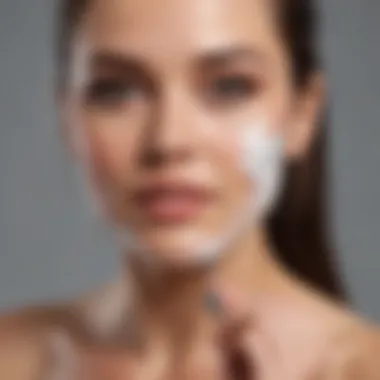Comprehensive Guide to Shaving Your Bikini Area Safely


Intro
Navigating the intricacies of personal grooming is essential for many women. In particular, the bikini area requires careful attention, considering both aesthetics and comfort. As fashion standards evolve, so do the techniques and methods used to maintain this area. This guide aims to enlighten you on effective shaving practices, potential skin issues, and alternative options. It is tailored specifically for women from various backgrounds aged 18 to 45, who seek clarity on this aspect of self-care.
The importance of looking good often intersects with feeling good. Exploring this balance between external appearance and internal confidence is crucial in today's society. As more women embrace personal grooming rituals, understanding the various techniques and products becomes a valuable skill. In the following sections, we will begin by examining the current fashion trends related to bikini grooming.
Prelude to Bikini Area Grooming
Bikini area grooming is more than a matter of aesthetics; it plays a significant role in personal hygiene and self-confidence. Understanding this topic is crucial, especially for women seeking to maintain their grooming routines and feel comfortable in their bodies. The presentation of oneself is often linked with personal care practices, which is why many women prioritize grooming in this sensitive area. This guide provides insights into effective and safe shaving, essential for achieving desired results without compromising skin health.
Understanding the Importance of Personal Grooming
Personal grooming serves multiple purposes, from enhancing personal hygiene to boosting self-esteem. For many women, shaving the bikini area is part of regular grooming rituals. The act of grooming can signify respect for oneself and the desire to present oneself well in social situations.
In addition, proper care in the bikini area can prevent skin irritations and other health issues, such as infections caused by improper hygiene. Shaving can minimize discomfort during activities like swimming or wearing tight clothing, thus improving overall comfort. Ultimately, establishing a routine that works for individual needs goes a long way in promoting both comfort and confidence.
Cultural Perspectives on Bikini Grooming
Cultural attitudes toward bikini grooming vary greatly. In some societies, hair removal in the bikini area is seen as a standard practice, often related to fashion trends, while in others, it may be viewed as unnecessary. This divergence highlights the influence of media and societal norms.
In certain communities, bikini grooming reflects personal choices that align with broader lifestyle preferences. For example, some women groom to abide by popular beauty standards set by celebrities and influencers, while others may choose to embrace their natural appearance, resisting societal pressures. Understanding these perspectives allows women to make informed choices about their grooming routines, aligned with their values and preferences.
"Grooming practices are deeply personal and reflect one's unique identity and choices."
It's essential to recognize that personal grooming, including bikini area shaving, ultimately reduces down to individual preference. As women explore their options, being aware of diverse cultural viewpoints ensures well-informed decisions regarding their grooming habits. This guide seeks to offer useful techniques and an understanding of these multifaceted aspects of bikini area grooming.
Preparing for the Shave
Preparing for shaving the bikini area is critical for achieving smooth skin and minimizing discomfort. Proper preparation can significantly enhance the shaving experience and reduce the chances of irritation or skin issues. This section covers essential tools for effective shaving and the importance of pre-shave skin preparation. By focusing on these elements, readers can enjoy a more comfortable and effective grooming routine.
Essential Tools for Shaving
Choosing the right tools is essential for a safe and effective shave. Using appropriate tools can make the process smoother and help achieve a better result.
Razor Types
There are various razor types available, including disposable, safety, and electric razors. Each type has its own benefits. Disposable razors are convenient and inexpensive, making them a popular choice for many. However, they may not offer the same precision as other options. Safety razors, on the other hand, are known for their durability and closeness of shave. They can reduce the risk of nicks and cuts if used correctly. Different razors serve different needs and preferences, making the selection process important.
Shaving Creams and Gels
Selecting an appropriate shaving cream or gel is pivotal in ensuring a smooth shave. These products help soften hair and provide a protective barrier between the skin and the razor, reducing friction. A key characteristic of good shaving gels is their cushioning effect that helps prevent razor burn. Some products also contain soothing ingredients like aloe vera that can calm the skin during and after shaving. The variety of options available allows for choices that align with skin types and personal preferences.
Exfoliation Tools


Exfoliation tools, such as loofahs or exfoliating gloves, are useful before shaving. They help remove dead skin cells and prevent ingrown hairs. Regular exfoliation can keep the skin smooth and even in texture, which is particularly beneficial for the bikini area. Using these tools adds an extra layer of care to grooming practices, making them a popular choice for many. Consistent exfoliation can lead to healthier skin, yet caution is needed to avoid over-exfoliating, which can cause irritation.
Pre-Shave Skin Preparation
Before shaving, skin preparation is critical. Properly preparing the skin enhances the shaving experience and can prevent common post-shave issues. This section emphasizes the main aspects of pre-shave skin care that are essential for achieving optimal results.
Exfoliating the Skin
Exfoliating the skin is a vital step in pre-shave preparation. It helps remove dead skin cells, allowing for a closer and more comfortable shave. When exfoliating, it’s important to use gentle methods to avoid irritating the sensitive skin in the bikini area. This step can significantly decrease the occurrence of ingrown hairs, making it a beneficial practice in any shaving routine. While exfoliating regularly can benefit the skin, doing it too often may lead to sensitivity.
Moisturizing Techniques
Moisturizing the skin before shaving ensures it stays hydrated and healthy. Applying a light moisturizer helps maintain skin elasticity and creates a barrier that reduces razor irritation. Using products that are fragrance-free and specifically formulated for sensitive skin is advisable. The unique feature of lightweight moisturizers is that they absorb quickly, preparing the skin without leaving a greasy residue. Proper moisturization aids in achieving a more comfortable shave and lessens any irritation post-shave.
Choosing the Right Time to Shave
Timing can play an important role in the shaving experience. It is often recommended to shave during or after a warm shower. Warm water helps soften hair and open pores, allowing for a smoother shave. Choosing the right time can also depend on personal schedules and skin sensitivity. While there is flexibility in timing, finding a routine that incorporates these elements can help optimize the shaving process and overall experience.
Techniques for Effective Shaving
The section on Techniques for Effective Shaving is crucial for anyone seeking to achieve a smooth bikini area. This process encompasses various elements such as preparation, the actual shaving techniques, and post-shave care, each contributing significantly to the overall results. Proper shaving techniques will not only help in achieving desired smoothness but also minimize the risks of skin irritation and ingrown hairs, which are common concerns among those who groom the bikini area. Understanding how to shave effectively means embracing both artistry and technique, equipping the individual with the knowledge needed to make informed choices.
Step-by-Step Shaving Process
Trimming Long Hair
Trimming long hair is a foundational step before engaging in the actual shaving process. By managing the length of hair, the razor can glide more smoothly over the skin, reducing the chances of tugging and irritation. This aspect is particularly beneficial for those with thicker or longer hair. The key characteristic of trimming is that it prepares the hair for a much cleaner shave. Not only does trimming reduce the risk of razor burn, but it also allows for a quicker and more efficient shave overall. A unique feature of this step is the ease with which it can be done at home using simple scissors or an electric trimmer. However, it is important to note that trimming does not remove hair completely, which may lead some to think it’s an unnecessary step.
Applying Shaving Cream
Applying shaving cream creates a protective barrier between the skin and the razor. This aspect is essential as it prevents direct contact of the blade with the skin, which can cause irritation. The key advantage of using shaving cream lies in its ability to soften the hair, making it easier to shave off. A unique feature of high-quality shaving creams is their moisturizing properties, which help to keep the area hydrated during the shave. This approach not only decreases friction but also enhances comfort. However, there are varying opinions on whether to use gel or cream, with gels sometimes being favored for their transparency, allowing the user to see the area better.
Shaving Direction and Technique
The direction and technique of shaving play a pivotal role in the outcome. Shaving in the direction of hair growth initially helps reduce irritation and allows users to become familiar with their skin's contours. A notable advantage of this method is it minimizes the risk of cuts. Conversely, some individuals prefer to shave against the grain for a closer shave. This unique feature can achieve optimal results but may also incur a higher risk of skin bumps or irritation. Therefore, understanding one's hair growth patterns and how your skin reacts is key to choosing the right technique.
Post-Shave Care
The post-shave process is just as important as the actual shave. Proper aftercare can counteract any irritation and promote healthier skin.
Soothing Irritated Skin
Soothing irritated skin is a necessary step after shaving. This aspect of post-shave care helps in calming any inflammation that may arise from the shaving process. A key characteristic of this stage is the use of products like aloe vera or witch hazel that are known for their soothing properties. These products provide immediate relief, and they can be very beneficial for those with sensitive skin. The unique feature of applying soothing balms is their ability to form a protective layer over the skin, thus offering a barrier against infection or further irritation. However, it is crucial to confirm that these products do not contain harsh ingredients that could exacerbate irritation.
Hydration and Moisturizing


Hydration and moisturizing are vital for maintaining skin health after shaving. This step replenishes moisture lost during the shaving process and aids in rebuilding the skin's natural barrier. A key reason to prioritize this step is to prevent dryness, which can lead to discomfort and irritation. Utilizing a good moisturizer tailored for sensitive skin not only hydrates but can also enhance the smoothness of the bikini area. The unique aspect of this care is that regular moisturizing can also reduce the appearance of ingrown hairs over time. While some may skip this step due to time constraints, neglecting hydration can result in poor skin conditions.
Avoiding Common Post-Shave Issues
Avoiding common post-shave issues is essential for long-term skin health. This section involves understanding what can go wrong after shaving, such as developing bumps, ingrown hairs, or allergic reactions. A key characteristic of this step is prevention; it focuses on identifying potential hazards before they occur. Choosing suitable products, like unscented lotions and alcohol-free aftershaves, is crucial. The unique feature of educating oneself about personal triggers can be a game-changer. For example, some may find that synthetic fragrances irritate their skin, leading to rashes. Being proactive in avoiding these issues allows for a more comfortable grooming experience.
The careful attention to techniques and care can significantly transform the overall experience of grooming the bikini area.
Potential Challenges and Solutions
Navigating the process of shaving the bikini area can bring about various challenges. Understanding these potential issues is vital for achieving a comfortable and effective grooming experience. This section discusses common concerns, specifically ingrown hairs and skin irritation, along with strategies for prevention and treatment. Recognizing these challenges will enable individuals to make informed decisions about their grooming practices, resulting in a more satisfying outcome.
Dealing with Ingrown Hairs
Ingrown hairs are a frequent concern when shaving the bikini area. They occur when hair grows back into the skin rather than outward. This can lead to discomfort, redness, and sometimes infection. The key to managing this issue lies in effective prevention and treatment strategies.
Prevention Strategies
Preventing ingrown hairs involves careful preparation and technique. One important aspect is exfoliating the skin before shaving. This helps remove dead skin cells, easing the path for hair to grow out. Using a body scrub or exfoliating mitt before shaving can significantly reduce the likelihood of ingrown hairs. Additionally, applying a moisturizing shaving cream can create a smoother surface, allowing the razor to glide more smoothly.
In summary, employing a proactive approach such as regular exfoliation and using quality shaving products are beneficial tactics to reduce the occurrence of ingrown hairs.
Treatment Methods
When ingrown hairs do occur, addressing them promptly is essential. A common treatment method is to gently apply warm compresses to the affected area. This can help reduce inflammation and encourage the hair to break through the skin's surface. If an ingrown hair remains persistent, a sterile needle may be used to gently lift it out. It is crucial, however, to avoid picking at the area, as doing so can result in further irritation or infection.
Thus, timely and safe treatment practices improve the experience and reduce complications associated with ingrown hairs.
Skin Irritation and Allergies
Another challenge women face when shaving the bikini area is skin irritation and allergic reactions. These can manifest as redness, bumps, or itching. Understanding the causes of irritation is key to avoiding these reactions.
Identifying Triggers
Identifying triggers for skin irritation is important for tailoring a shaving routine to an individual's needs. Common triggers include harsh chemicals found in some shaving creams, or specific fragrances in personal care products. Conducting patch tests before the full application of any product can assist in recognizing potential allergens. Additionally, observing any patterns in irritation post-shave can help identify what products or methods to avoid.
Therefore, being attentive to personal skin reactions allows for more informed choices in product selection.
Choosing Hypoallergenic Products
Selecting hypoallergenic products is a highly effective approach for mitigating skin issues. These products are formulated to minimize allergic reactions and are often free of irritants. Using hypoallergenic shaving creams and aftershaves can provide an extra layer of protection for sensitive skin. It is essential to read labels carefully and opt for products that cater specifically to sensitive areas like the bikini line.
Alternatives to Traditional Shaving


Exploring alternatives to traditional shaving is vital for anyone contemplating grooming the bikini area. This section addresses various methods, each with its unique features and considerations. By understanding these options, individuals can choose a method that best aligns with their skin type, pain tolerance, and personal preferences.
Hair Removal Creams
Efficacy and Safety
Hair removal creams, often known as depilatories, dissolve hair at the skin's surface. They are generally considered effective, providing a quick solution for hair removal. One major characteristic is their ability to cover large areas in a short time. However, safety should be a priority. These creams contain chemicals that might irritate sensitive skin or cause allergic reactions. It is important to perform a patch test on a small skin area before full application. The main advantage of hair removal creams is their ease of use and the lack of risk of cuts or nicks associated with razors.
Application Guidelines
Using hair removal creams correctly is crucial for achieving desired results and minimizing skin irritation. Begin by thoroughly cleaning the area to remove any dirt or oils. Apply an even layer of the cream, making sure to follow the recommended guidelines on the packaging. Avoid exceeding the suggested duration, as prolonged contact can lead to chemical burns. Rinse the product off gently with lukewarm water. Careful application can lead to smooth skin for several days. However, note that this method may not provide long-lasting results compared to other options.
Waxing and Sugaring
Benefits vs. Drawbacks
Waxing and sugaring involve removing hair from the root, which can result in smoother skin for a more extended period compared to shaving. A key benefit is that these methods often lead to finer regrowth over time. However, both techniques can be painful, especially in sensitive areas such as the bikini line. Waxing may cause skin irritation, and there is a risk of ingrown hairs. Sugaring can be gentler on the skin, as it uses a natural paste, making it a popular choice for those seeking a less painful experience. Understanding personal pain thresholds is essential when considering these methods.
Professional vs. At-Home Options
Choosing between professional and at-home waxing or sugaring depends on individual comfort levels and budget. Professional options provide expert knowledge and typically better results due to experience. Moreover, professionals are equipped to handle any skin reactions. However, appointments can be pricey and may require traveling. At-home kits offer a more affordable alternative, but they may require practice to achieve optimal results. Users should weigh convenience against potential cost savings when deciding the best course of action for their grooming needs.
Laser Hair Removal
Understanding the Process
Laser hair removal uses concentrated light beams to target hair follicles. This method is designed to provide permanent hair reduction. It often requires multiple sessions for the best results, making it a long-term commitment. One of the main benefits of this method is that it minimizes potential for ingrown hairs compared to shaving or waxing. However, it can be expensive and may not be effective on all skin and hair types. Patients with light skin and dark hair tend to see the best outcomes due to the contrast.
Cost Considerations and Results
Laser hair removal can be a significant financial commitment, often ranging from several hundred to thousands of dollars over the full course of treatment. The investment can be justified by the potential to significantly reduce hair growth long-term. Clients must consider that multiple treatments are required to achieve optimal outcomes, impacting overall cost. However, many find that the effectiveness and permanence of the results are worth the initial expense. Being aware of these considerations can help manage expectations and budgeting for beauty care.
Epilogue
In the realm of personal grooming, shaving the bikini area occupies a significant role. It is essential not only for aesthetic appeal but also for comfort and hygiene. The choice to shave, wax, or use alternative hair removal methods is highly personal and varies from individual to individual.
Choosing the Best Method for You
Selecting the most suitable hair removal technique involves considering several factors. These include skin type, hair thickness, and tolerance for pain. Additionally, one’s lifestyle and personal preferences should guide this decision. For instance, those with sensitive skin may find that shaving leads to irritation, while waxing may not be suitable for someone who prefers a less painful experience.
- Shaving: Quick and easy, suitable for various skin types, but requires continuous maintenance.
- Waxing: Offers longer-lasting results, though it can be painful and requires hair to be of a certain length.
- Hair Removal Creams: Chemical-based options that are effective but may have adverse skin reactions.
- Laser Hair Removal: A long-term solution with significant upfront costs. Results can vary based on hair type and skin tone.
"The best method for you is the one that aligns with your personal values, comfort level, and lifestyle needs."
The Role of Personal Preference in Grooming
Personal preference plays a critical role in grooming choices, including shaving the bikini area. Factors such as cultural influences, environmental exposure, and individual self-image can sway these preferences. Some may opt for a fully groomed appearance, while others prefer natural growth.
Understanding one's own preferences is vital for a satisfactory grooming experience. This involves experimenting with different methods and assessing what feels best physically and emotionally. Personal grooming is ultimately an expression of individuality. Prioritizing comfort and satisfaction will always yield the best outcomes.
In summary, the considerations outlined in this guide offer a detailed framework for approaching bikini area shaving. With proper knowledge and thoughtful reflection on personal preferences, anyone can navigate the myriad of options available, resulting in an experience that is tailored to their needs.



